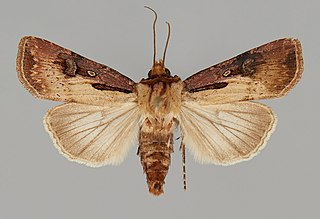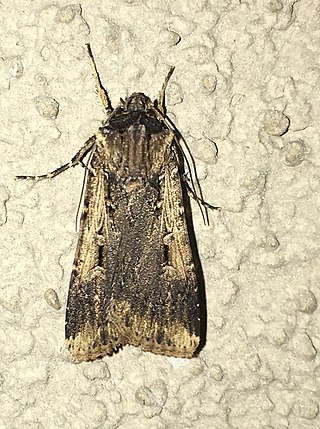
Agrotis segetum, sometimes known as the turnip moth, is a moth of the family Noctuidae. The species was first described by Michael Denis and Ignaz Schiffermüller in 1775. It is a common European species and it is found in Africa and across Eurasia except for the northernmost parts.

The heart and club is a moth of the family Noctuidae. It is distributed throughout the Palearctic realm.

Schinia, commonly called flower moths, is a large genus of moths belonging to the family Noctuidae. The genus has a Holarctic distribution with the vast majority of species being found in North America, many with a very restricted range and larval food plant.

Agrotis is a genus of moths of the family Noctuidae. The genus was erected by Ferdinand Ochsenheimer in 1816. A number of the species of this genus are extinct.

Agrotis ipsilon, the dark sword-grass, ipsilon dart, black cutworm, greasy cutworm or floodplain cutworm, is a small noctuid moth found worldwide. The moth gets its scientific name from black markings on its forewings shaped like the letter "Y" or the Greek letter upsilon. The larvae are known as "cutworms" because they cut plants and other crops. The larvae are serious agricultural pests and feed on nearly all varieties of vegetables and many important grains.
Agrotis cremata was a moth in the family Noctuidae. It is now presumed extinct.

Agrotis vetusta, the old man dart, spotted-legged cutworm or muted dart is a moth of the family Noctuidae. The species was first described by Francis Walker in 1865. It is found in North America, from southern Alaska to Nova Scotia, southward into Mexico.

Actebia fennica, the black army cutworm or Eversmann's rustic, is a moth of the family Noctuidae. The species was first described by August Michael Tauscher in 1806. It has a Holarctic distribution from Newfoundland through western Europe, Siberia, the Far East, Mongolia, northern China to Korea and Japan. In North America it is mainly found in the boreal region, south to New England, southern Montana and northern Oregon.

Agnorisma bugrai, the collard dart, is a moth of the family Noctuidae. The species was first described by Ahmet Ömer Koçak in 1983. It has a transcontinental distribution in North America, from central Canada and the northern United States, southward in the Rocky Mountains to Colorado.

Agrotis daedalus is a species of moth in the family Noctuidae. It is found throughout the Great Plains, from west Texas, New Mexico and Arizona west to northern Nevada north to southern Alberta and south central Saskatchewan.

Agrotis obliqua is a moth of the family Noctuidae first described by Edgar Albert Smith in 1903. It is found in North America from Newfoundland to Vancouver Island, and south to Colorado, Arizona and California.

Agrotis robustior is a moth of the family Noctuidae first described by Smith in 1899. It is found on the northern Great Plains of North America, the Prairie Provinces of Canada southward to South Dakota and Colorado.

Agrotis venerabilis, the dusky cutworm, is a moth of the family Noctuidae. The species was first described by Francis Walker in 1857. It is found from coast to coast from central Canada south to Mexico.

Agrotis cinerea, the light feathered rustic, is a moth of the family Noctuidae. The species was first described by Michael Denis and Ignaz Schiffermüller in 1775. It is found in southern and central Europe, northern Turkey, the Caucasus, western Turkmenia and Central Asia.

Agrotis ripae, the sand dart, is a moth of the family Noctuidae. The species was first described by Jacob Hübner in 1823. It is found in western Europe and North Africa and extends east across the Palearctic to steppe areas in Russia, Mongolia and Siberia.

Agrotis stigmosa is a moth of the family Noctuidae first described by Herbert Knowles Morrison in 1875. It is found in North America from New England and Quebec west to Colorado and eastern Alberta. It is listed as a species of special concern in the US state of Connecticut.

Agrotis vancouverensis, the Vancouver dart, is a moth of the family Noctuidae. The species was first described by Augustus Radcliffe Grote in 1873. It is found in the Pacific Northwest of North America and is common west of the Cascade Mountains.

Agrotis volubilis, the voluble dart moth, is a moth of the family Noctuidae. The species was first described by Leon F. Harvey in 1874. It is found in North America, from Newfoundland to British Columbia in Canada and in the United States from Maine to Florida and west to the West Coast.

Agrotis amphora is a species of moth of the family Noctuidae. It is found in Kashmir.

Agrotis trux, the crescent dart, is a moth of the family Noctuidae. The species was first described by Jacob Hübner in 1824. It has a circum-Mediterranean distribution and is found along the coasts of France, Ireland, England, southern Europe, Algeria, Syria, Iraq, Iran, southern Russia and the Arabian Peninsula. In Africa, it is found as far south as South Africa.


















